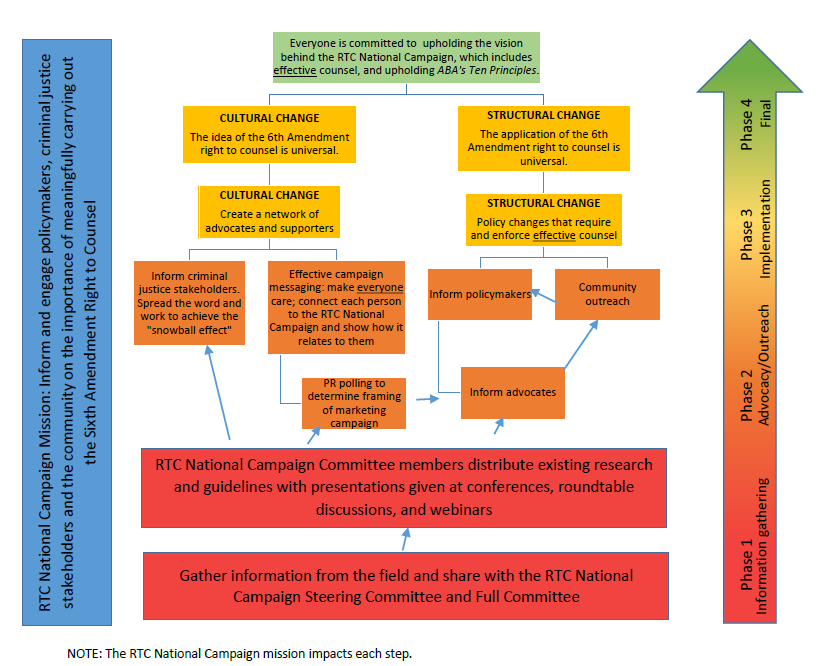Right to Counsel National Campaign’s Theory of Change
The theory of change (TOC) for the Right to Counsel National Campaign (R2C) was designed to map out the steps needed to achieve the campaign’s overall goal of ensuring that the Sixth Amendment right to counsel is meaningfully implemented throughout the country.
Theory of change is based on four tenets:
Right to Counsel National Campaign Vision: A fair and equitable criminal justice system requires representation by skilled defense counsel with adequate resources at every stage of the criminal process.
Everyone has the constitutional right to an attorney.
The Sixth Amendment right to counsel ensures equality and equity.
Public defense services are delivered within the framework of ABA's Ten Principles.
Theory of change recognizes these existing external conditions:
A lack of awareness exists about a) what the right to counsel means and b) that it isn't being upheld.
Public defense is often left out of the criminal justice reform conversation.
Public defenders often operate with little and too few resources to provide effective counsel.
There is a lack of consistency across the delivery of public defense nationwide.
Theory of change consists of four phases:
Benchmarks: Each phase of the TOC has benchmarks that R2C is measuring its progress against and by which consortium members can track their own progress.
Phase One: Information Gathering
Gather information and share with R2C committees
- Hold R2C National Consortium Committee Meetings with full committee members and steering committee members
- Hold conference calls to share information with committee members and hold calls to disseminate information to other system actors
- Gather data, documents, and reports regarding criminal justice and public defense reform efforts
- Identify consortium members
- Conduct internal in-depth interviews with full committee members to help
Share information beyond consortium members
- Present at conferences and other relevant meetings
- Conduct webinars
- Get new signatories.
Phase Two: Advocacy and Outreach
- Hold annual R2C meetings
- Recruit new consortium members
- Build partnerships outside of the consortium
- Develop right to counsel champions
- Develop and implement a social media strategy
- Document reform movements, such as general criminal justice reforms and public defense-specific reforms
- Hold public focus groups and conduct opinion polling
- Convene system actor focus groups
- Continue to present at conferences and webinars
- Develop and release public and system actor communication toolkits
- R2C champion introduces new legislation
- R2C champion introduces new state guidelines
Phase Three: Implementation
Structural changes
- Legislation is passed
- New policies are implemented
- ABA (or state) guidelines are adopted in all local, state, and federal jurisdictions
Cultural changes
- Americans know that the right to counsel stems from the U.S. Constitution
- There is a shared commitment to uphold this constitutional right
- Public defense service providers are no longer identified as “lazy,” “not real lawyers,” “not committed,” etc.
- Media recognizes the role of public defense service providers and portrays them positively
Phase Four: Final
- Everyone has access to an effective attorney with the time, knowledge, experience, and resources available to provide a quality defense
- Consequences are enforced if the Sixth Amendment right to counsel is not upheld
- Consequences are enforced if ABA (or state) guidelines are not followed
More information about the TOC can be found here.



